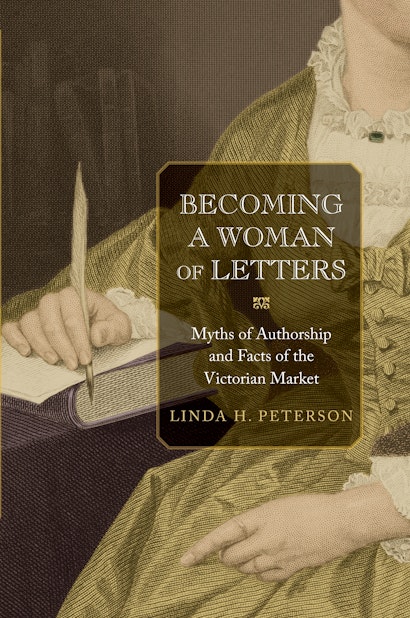During the nineteenth century, women authors for the first time achieved professional status, secure income, and public fame. How did these women enter the literary profession; meet the demands of editors, publishers, booksellers, and reviewers; and achieve distinction as “women of letters”? Becoming a Woman of Letters examines the various ways women writers negotiated the market realities of authorship, and looks at the myths and models women writers constructed to elevate their place in the profession.
Drawing from letters, contracts, and other archival material, Linda Peterson details the careers of various women authors from the Victorian period. Some, like Harriet Martineau, adopted the practices of their male counterparts and wrote for periodicals before producing a best seller; others, like Mary Howitt and Alice Meynell, began in literary partnerships with their husbands and pursued independent careers later in life; and yet others, like Charlotte Brontë, and her successors Charlotte Riddell and Mary Cholmondeley, wrote from obscure parsonages or isolated villages, hoping an acclaimed novel might spark a meteoric rise to fame. Peterson considers these women authors’ successes and failures—the critical esteem that led to financial rewards and lasting reputations, as well as the initial successes undermined by publishing trends and pressures.
Exploring the burgeoning print culture and the rise of new genres available to Victorian women authors, this book provides a comprehensive account of the flowering of literary professionalism in the nineteenth century.
Linda H. Peterson is the Niel Gray, Jr. Professor of English at Yale University. Her books include Victorian Women's Autobiography: The Poetics and Politics of Life Writing.
"Peterson's study is not simply a fascinating contribution to the nineteenth-century history of authorship, it is also an interesting example of the uses of the biographical and autobiographical writings of literary figures by their creators or by other writers for the purposes of self-mythologization or the creation of gendered myths of authorship. . . . This is very much a contribution to the bigger picture on the nineteenth-century history of authorship, and a model for further scholarship in this area."—Lyn Pykett, Biography
"[T]he wealth of information contained in Becoming a Woman of Letters will be of invaluable help not only to those who want to study these individual women, but those who are interested in nineteenth century women writers as a group, and in the Victorian publishing world. Peterson's work allows us to see the importance of contextualizing whenever we consider an individual's work, for even literary geniuses who are born and bred in the wilds of the Yorkshire moors must work within the context of the market."—Christine DeVine, Journal of Pre-Raphaelite Studies
"Peterson's project is a stunning success. The book embodies all that we expect of criticism these days. Peterson's readings are insightful, her range of reference astounding, but it is the methods of her scholarship that seem most pertinent in making this a book we should offer as a benchmark to our students."—Laurie Langbauer, Tulsa Studies in Women's Literature
"Peterson's prose is often incisive, compact, and elegant. Her generous yet deftly chosen illustrations amplify her arguments and deepen the literary and historical richness of this insightful study of Victorian women and authorship."—Cheri L. Larsen Hoeckley, Christianity and Literature
"With this wide-ranging and ambitious study, Linda H. Peterson makes a significant contribution to our understanding of the professionalisation of writing throughout the nineteenth century."—Routledge Annotated Bibliography of English
"Her book avowedly contributes to the goal of a complete literary history of women's writing in the nineteenth century. Becoming a Woman of Letters is a major contribution to that history."—Alison Booth, Modern Philology
"Written in transparently lucid prose, this book offers a deeply informed, evenhanded assessment of the several models of female authorship that circulated from the 1830s to the 1890s. The book deftly shows how Victorian myths of female authorship both emerged and diverged from the professional biographies of these women of letters."—Rosemarie Bodenheimer, Boston College
"Becoming a Woman of Letters makes a significant contribution to our understanding of the nineteenth-century literary marketplace and of how women located themselves within the emerging profession of authorship. Elegant and engagingly written, this book will appeal to readers with an interest in the history of authorship, in the periodical press, and in women's writing."—Hilary Fraser, Birbeck College, University of London

